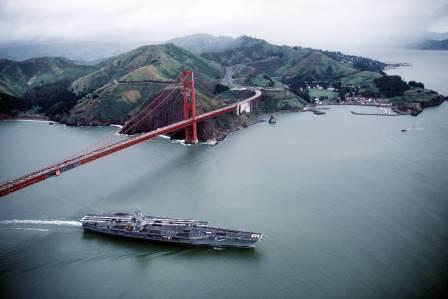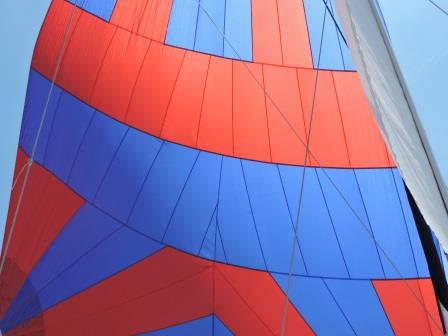
It’s a rare day that we can fly the big blue and red spinnaker off the bow. We need just the right direction of wind to sail upwind so as to turn back 180 degrees and let loose. On this day we went spinnaker sailing twice.
An east wind in the morning picked up to 8 mph and let us tack downriver. I was especially eager to raise the spinnaker because we had on board Mario Cockrell and his family. He’s a retired Army paratrooper with the 82nd Airborne and 173rd Airborne divisions at Ft. Bragg, North Carolina. Others on board wondered the distinction between free falling and static line jumping.
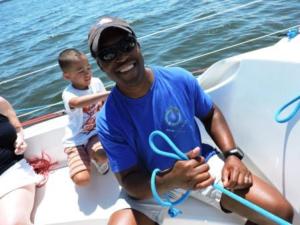 “We jump with a static line which pulls a pin from the parachute to deploy it. Bang, bang! Things happen very quickly as we move out of the plane. We fly low altitude at 1500 feet but jump as low as 800 feet. Free fall has them jumping at much higher altitudes and takes surprisingly little time. I’ve been on the ground after one jump and watched free fallers go three times in the same day. They take off in a small plane and get up there and jump. I’ve done 172 jumps.”
“We jump with a static line which pulls a pin from the parachute to deploy it. Bang, bang! Things happen very quickly as we move out of the plane. We fly low altitude at 1500 feet but jump as low as 800 feet. Free fall has them jumping at much higher altitudes and takes surprisingly little time. I’ve been on the ground after one jump and watched free fallers go three times in the same day. They take off in a small plane and get up there and jump. I’ve done 172 jumps.”
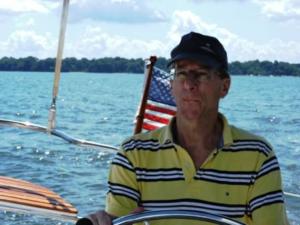 Chris Carson handled the helm ably on the downwind leg. He quickly found how sensitive the wheel is because the boat is essentially surfing downhill instead of pulling uphill. He found it exciting.
Chris Carson handled the helm ably on the downwind leg. He quickly found how sensitive the wheel is because the boat is essentially surfing downhill instead of pulling uphill. He found it exciting.
Hard Landing
Once we got the spinnaker up and out, Mario saw the configuration of a parachute. “It’s hard on the other side.” What? “On the front side of the spinnaker the wind makes the sail very hard.” This seemed consistent with the oddity that the tack line at the base of the sail has 1,000 pounds of pressure and requires block and tackle to pull it down under pressure.
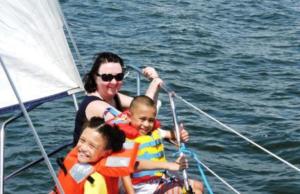 “We’re taught in training not to get near another parachute below us. You land on it and it can be a hard landing. If that happens, you’re supposed to scurry your feet quickly to walk off it before it collapses or the guy’s feet come through the fabric. I weighed 165 when I jumped, and bigger guys with equipment on their backs would land on my chute. I could hear them walking off. You’ve got 4,000 people jumping in the dark of night, so it’s a lot to keep track of to avoid each other.”
“We’re taught in training not to get near another parachute below us. You land on it and it can be a hard landing. If that happens, you’re supposed to scurry your feet quickly to walk off it before it collapses or the guy’s feet come through the fabric. I weighed 165 when I jumped, and bigger guys with equipment on their backs would land on my chute. I could hear them walking off. You’ve got 4,000 people jumping in the dark of night, so it’s a lot to keep track of to avoid each other.”
Norway Connection
Mario’s wife Sue enjoyed quiet time on the bow with their two children and by herself. “I’m from Oslo. There’s something about the smell of the ocean. I love that smell.” They met at Ft. Bragg when she was an exchange student.
Boating Story
Mario recalled, “I was a kid in 1983 living in the Bay Area when the aircraft carrier Enterprise ran aground. It hit a sandbar while coming in San Francisco Bay to Alameda. It wound up sideways for three days. A fleet of tugboats had to go out there to push and pull it from sideways to straight. My dad was retired from the Marines, and all he could think of was the damage from all those planes breaking their chains when the ship stopped suddenly.”
Second Spinn
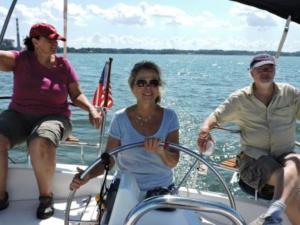 Conditions were ideal once again for the afternoon sail. This time we had experienced sailor Corinna Caldwell with her brother Doug and his wife Maryellen. The wind picked up, so we zoomed all the way out to the Severn River entrance before tacking downwind on the spinnaker. I could tell Doug had a background that commended his work on the helm. Are you a musician, I asked. “I am.” He and Maryellen play and teach music.
Conditions were ideal once again for the afternoon sail. This time we had experienced sailor Corinna Caldwell with her brother Doug and his wife Maryellen. The wind picked up, so we zoomed all the way out to the Severn River entrance before tacking downwind on the spinnaker. I could tell Doug had a background that commended his work on the helm. Are you a musician, I asked. “I am.” He and Maryellen play and teach music.
Let’s Go Sail
Check rates and pick a day for a sailboat charter. See reviews on Trip Advisor from sailors like you.

